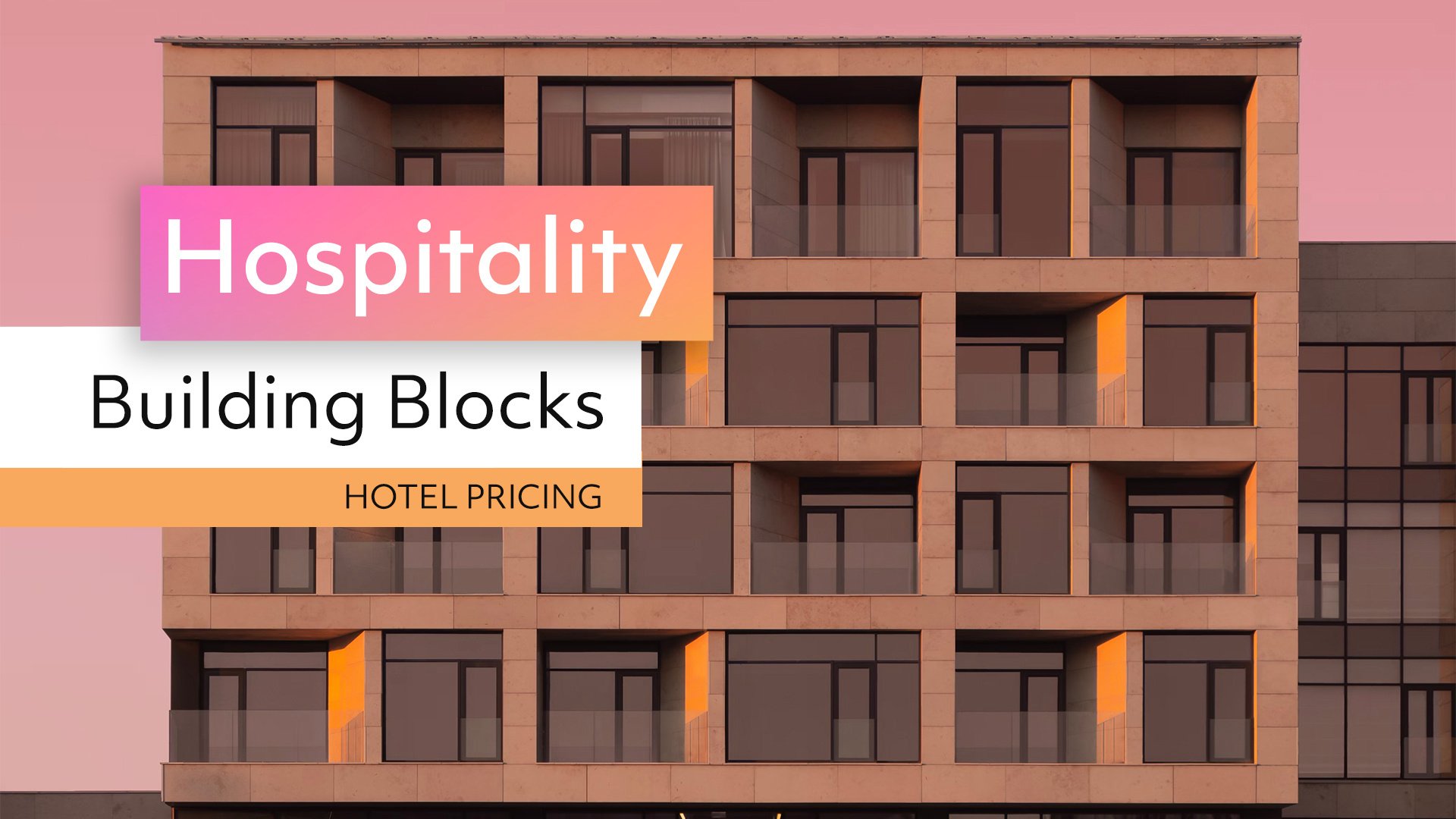- Introduction to Hotel Pricing
- Factors Influencing Hotel Room Rates
- The Evolution from Seasonal to Dynamic Pricing
- The Role of Revenue Management Professionals
- Leveraging Advanced Revenue Management Systems
- The Role of Business Intelligence in Hotel Pricing
- Segmentation and Room Type Pricing
- Establishing Best Available Rates (BAR) and Discounting Strategies
- Bundling and Packaging Offers
- Channel Distribution and Commission Management
- Loyalty Programs and Their Impact on Pricing
- Emerging Metrics: TrevPAR and GOPPAR
- Personalized Pricing Strategies
- Applying Dynamic Pricing Beyond Rooms
- Profit-Focused Pricing and Distribution Decisions
- External Hotel Pricing Resources
- Related Otelier Resources on Hotel Pricing
With multiple competing hotels likely right across your streetcorner, establishing an effective hotel pricing strategy is paramount to ensure your hotel’s long-term success. With proper hotel pricing, your hotel will be set up to maximize revenue and ensure guest satisfaction. A well-crafted pricing approach not only reflects the value proposition of the property but also adapts to market dynamics, consumer behavior, and operational costs. By understanding and implementing strategic pricing, hoteliers can position their establishments favorably within the market, attract diverse guest segments, and optimize revenue.
Otelier Can Inform Your Hotel Pricing Strategy
Learn how Otelier can provide a 360-degree view of your business and your guests for a more effective hotel pricing strategy.
[ Learn more ]
Factors Influencing Hotel Room Rates
Determining the appropriate room rate involves a multifaceted analysis of various internal and external factors. Key considerations include:
- Market Demand: Fluctuations in traveler demand, influenced by seasonality, local events, and economic conditions, play a significant role in pricing decisions.
- Operational Costs: The expenses associated with running the hotel, such as staffing, utilities, maintenance, and amenities, must be covered and factored into room rates.
- Room Turnover Costs: The cost to "flip" a room, including cleaning, restocking, and minor repairs, impacts the pricing structure.
- Property Attributes: Features such as location, star rating, on-site facilities, and the property's age or recent renovations can justify premium pricing.
- Competitive Set Analysis: Evaluating the rates and offerings of nearby or similar hotels helps in positioning one's pricing competitively within the market.
By meticulously analyzing these factors, hoteliers can set room rates that align with their financial objectives while meeting market expectations.
The Evolution from Seasonal to Dynamic Hotel Pricing
Historically, hotels adjusted their room rates based on broad seasonal trends, offering fixed prices for peak and off-peak periods. However, the 1980s marked a paradigm shift with the adoption of dynamic pricing models, inspired by the airline industry's yield management practices. This approach involves real-time adjustments to room rates based on current demand, booking patterns, and market conditions. Advancements in technology and data analytics have further refined dynamic pricing, enabling hotels to modify rates multiple times a day to optimize revenue and occupancy. This agile pricing strategy allows properties to respond swiftly to market fluctuations, competitor actions, and changes in consumer behavior.
The Role of Revenue Management in Hotels
The complexity of modern pricing strategies necessitates dedicated roles focused on revenue optimization. A Director of Revenue Management (DORM) may oversee the pricing strategy at one hotel or several. At the corporate level, Chief Commercial Officers and Vice Presidents of Revenue are now integral to hotel management structures. Each of these professionals is responsible for analyzing market data, forecasting demand, and implementing pricing strategies that align with a hotel – or a portfolio of hotel's – financial goals. Their expertise ensures that room rates are competitive yet profitable, balancing the twin objectives of maximizing occupancy and revenue. Collaboration with marketing, sales, and operations teams is essential to ensure cohesive strategies across all departments.
Leveraging Modern Revenue Management Systems
The advent of sophisticated Revenue Management Systems (RMS) has revolutionized how hotels approach pricing. These platforms process vast amounts of data, including historical booking patterns, competitor rates, market trends, and external factors such as local events or economic indicators. By analyzing this data, RMSs can recommend optimal pricing for different room types, distribution channels, and customer segments. Automation features allow for real-time rate adjustments, ensuring that pricing remains responsive to market dynamics. The integration of RMS with other hotel systems, such as Property Management Systems (PMS) and Customer Relationship Management (CRM) platforms, facilitates a holistic approach to revenue management.
The Role of Business Intelligence in Hotel Pricing
While an RMS is essential for optimizing room rates and maximizing top-line revenue, it only tells part of the story. Traditional RMS solutions focus primarily on room revenue, often overlooking critical ancillary revenue streams like food and beverage, spa services, parking, and event space. Additionally, RMSs traditionally prioritize topline growth without factoring in expenses, which can lead to revenue gains that don’t necessarily translate to increased profitability. In today’s hotel landscape, where rising labor costs and inflation are squeezing margins, a profit-focused strategy is crucial. This means going beyond just revenue optimization and considering the full financial picture when making pricing and business decisions.
This is where a Business Intelligence (BI) system like Otelier IntelliSight becomes indispensable. A BI platform aggregates and centralizes data from all departments – PMS, POS, accounting, labor management, and guest satisfaction scores—into a single, visualized dashboard. Instead of sifting through spreadsheets, hoteliers can quickly analyze trends, monitor KPIs, and make data-driven decisions using intuitive charts and graphs. By providing a holistic view of the entire operation, a BI system helps revenue teams collaborate with operations, finance, and marketing to drive not just more revenue, but smarter, more profitable revenue. With this level of visibility, hoteliers can better control costs, identify operational inefficiencies, and adjust strategies in real time—transforming data into action and revenue into profit.
Segmentation and Room Type Pricing
Effective pricing strategies recognize that not all guests have the same needs or willingness to pay. Segmenting the market allows hotels to tailor their offerings and prices to specific groups, such as business travelers, families, or leisure tourists. Additionally, differentiating pricing based on room types – such as standard rooms, deluxe rooms, and suites – enables hotels to capitalize on the varying needs among guests. Dynamic pricing can be applied within these segments, adjusting rates based on demand for each room category. This granular approach ensures that pricing is both competitive and reflective of the value provided to different guest segments.
Establishing Best Available Rates (BAR) and Discounting Strategies
The Best Available Rate (BAR) serves as a benchmark for a hotel's pricing structure, representing the lowest unrestricted rate available to the general public on a given day. From this baseline, hotels can implement various discounting strategies to attract specific segments or encourage direct bookings. For instance, offering discounted rates to loyalty program members, corporate clients, or guests booking extended stays can drive occupancy and build customer loyalty. It's crucial to manage these discounts carefully to avoid rate dilution and ensure that they align with the hotel's overall revenue management objectives.
Bundling and Packaging Offers
Instead of simply “discounting,” hotels often use bundling strategies to increase revenue and provide additional value to guests. By packaging room rates with other amenities such as dining, spa services, or golf, hotels create attractive offers that appeal to different market segments. These packages can be structured to drive bookings during low-demand periods or to cater to specific traveler needs.
Key Benefits of Bundling:
- Encourages guests to spend more on ancillary services.
- Increases overall guest satisfaction by providing a well-rounded experience.
- Helps differentiate a hotel from its competitors by offering exclusive packages.
Hotels can also collaborate with external partners, such as airlines and car rental companies, to create bundled offerings that enhance the travel experience. Effective marketing of these packages ensures visibility to the right audience and maximizes conversion rates.
Channel Distribution and Acquisition Costs
Hotel pricing is also influenced by distribution channels, including direct bookings, Online Travel Agencies (OTAs), and the Global Distribution System (GDS). Each of these channels comes with different commission structures and costs, making it essential for hotels to manage their mix effectively.
Strategies for Optimizing Distribution:
- Prioritizing direct bookings through website incentives and loyalty programs.
- Using metasearch platforms to balance visibility and commission costs.
- Evaluating the return on investment (ROI) of each distribution channel to maximize profitability.
By understanding the cost implications of each channel, hotels can make informed decisions on where to allocate inventory and how to structure pricing to maintain profit margins.
Loyalty Programs and Their Impact on Hotel Pricing
Loyalty programs play a crucial role in pricing strategy by incentivizing repeat business and increasing guest lifetime value. Many hotel brands allow members to earn points that can be redeemed for free stays, upgrades, or other perks.
How Loyalty Programs Influence Pricing:
- Encourages direct bookings by offering exclusive member rates.
- Allows for personalized pricing strategies based on guest history.
- Provides an opportunity to upsell premium rooms or ancillary services.
Hotels must ensure that loyalty-driven discounts do not erode revenue while maintaining an attractive value proposition for members.
Emerging Metrics: TrevPAR and GOPPAR
Traditionally, Revenue Per Available Room (RevPAR) has been the key performance metric in hospitality. However, newer metrics such as Total Revenue per Available Room (TrevPAR) and Gross Operating Profit per Available Room (GOPPAR) provide a more holistic view of profitability.
Key Differences:
- TrevPAR accounts for all revenue streams, including F&B, spa, retail, and more.
- GOPPAR factors in operating costs, giving a clearer picture of overall profit.
By shifting focus from top-line revenue to bottom-line profitability, hoteliers can make better strategic decisions that align with long-term financial success.
Personalized Hotel Pricing Strategies
With advancements in CRM and data analytics, hotels can now implement personalized pricing strategies tailored to individual guests. By analyzing past booking behavior, preferences, and spending patterns, hotels can offer dynamic rates that appeal to each traveler.
Benefits of Personalized Pricing:
- Enhances guest satisfaction by delivering customized offers.
- Increases conversion rates by presenting relevant price points.
- Encourages brand loyalty and repeat business.
By integrating CRM with RMS, hotels can execute personalized pricing at scale, ensuring each guest receives a competitive and tailored rate.
Applying Dynamic Pricing Beyond Rooms
While dynamic pricing has long been a standard practice for room rates, hotels are now applying similar strategies to other revenue-generating areas such as:
- F&B: Adjusting menu prices based on demand, dayparting, and seasonality.
- Spa & Wellness: Implementing peak and off-peak pricing to optimize appointment bookings.
- Golf & Recreation: Using variable pricing models for tee times based on demand patterns.
By leveraging dynamic pricing across multiple departments, hotels can maximize total revenue and ensure optimal resource utilization.
Profit-Focused Hotel Pricing and Distribution Decisions
One of the latest trends in revenue management is shifting focus from top-line revenue to profit optimization. This means considering costs such as:
- Housekeeping and labor costs per occupied room.
- Distribution channel commissions and marketing expenses.
- Variable costs associated with guest amenities and services.
By aligning pricing decisions with bottom-line profitability, hotels can now make pricing and distribution decisions based on which actions will drive the most to the bottom line. This, in turn, enhances financial performance and long-term sustainability.
Conclusion: Hotel Pricing Roadmap
In today’s fast-paced hospitality industry, hotel pricing strategies are no longer static – they require a deep understanding of demand patterns, distribution channels, guest segmentation, and operational costs. From leveraging advanced revenue management systems to applying dynamic pricing across multiple revenue streams, hotels must continuously evolve their pricing strategies to stay competitive. By focusing on total revenue metrics like TrevPAR and profitability measures like GOPPAR, hoteliers can ensure they are not just driving revenue but also optimizing bottom-line performance. A well-executed pricing strategy is key to sustainable growth, guest satisfaction, and long-term success.
Let’s discuss how Otelier can provide a 360-degree view of your business and your guests for a more effective hotel pricing strategy. Book a demo today.
External Hotel Pricing Resources
For further insights on hotel pricing strategies, refer to these top-ranking resources:
- Siteminder: Hotel pricing: Strategy and optimization guide
- Mews: The 20 best hotel pricing strategies to increase your revenue in 2024
- Hotel Tech Report: 17 Important Hotel Pricing Strategies for 2025
- eZee Absolute: Strategies for Maximizing Hotel Revenue through Rate Type Management
- Skift: 3 Charts That Show Hotel Prices Will Keep Rising
Related Otelier Resources on Hotel Pricing
Here are some resources from Otelier that expand on specific revenue management topics:
- 1. Next Up for Hotel Revenue Management: Tackling Ancillary Outlets
Explore how revenue management strategies can be applied beyond rooms, focusing on areas like F&B and spa services to enhance overall profitability. Read more.
- 2. Otelier on the Road: Investigating 2025 Demand Drivers at HDC
At the Hotel Data Conference, speakers suggested hoteliers find pockets of growth in 2025, including areas like group demand, advanced pricing strategies, and an emphasis on guest experience and innovation. Read more.
- 3. Hoteliers Move Beyond RevPAR for Hotel Business Intelligence
While RevPAR remains a useful metric for measuring a hotel's revenue performance, it should be considered alongside other bottom-line metrics to gain a more comprehensive understanding of hotel business intelligence. Read more.
- 4. Hotel Analytics: What Can Hoteliers Really Learn From TrevPAR?
Ancillary revenues are skyrocketing and total revenue figures can help hotels benchmark performance against their comp set, but operational decisions should be made by diving deeper into the right hotel analytics. Read more.
- 5. NYC Luxury Hotel Uses Hotel Budgeting and Forecasting Software To Shape Staffing
Learn how the real time data and reports from hotel budgeting and forecasting software by Otelier helps Rooms Operations Manager Cormac Daly, match inventory to staffing levels at the Lotte New York Palace. Read more.
- 6. Outrigger Gets Granular with Hotel Business Intelligence
James Wilson, director of Business Intelligence for Outrigger Resorts and KSL Resorts, is part of a team that has integrated data into its culture – no decisions across operations, marketing, sales are made without the analysis enabled by hotel business intelligence. Read more.
- 7. Determining the Most Accurate Data for Hotel Forecasting
As hoteliers prepare budgets, there are new, forward-looking hotel forecasting datasets that can provide more insight into demand trends. Read more.











